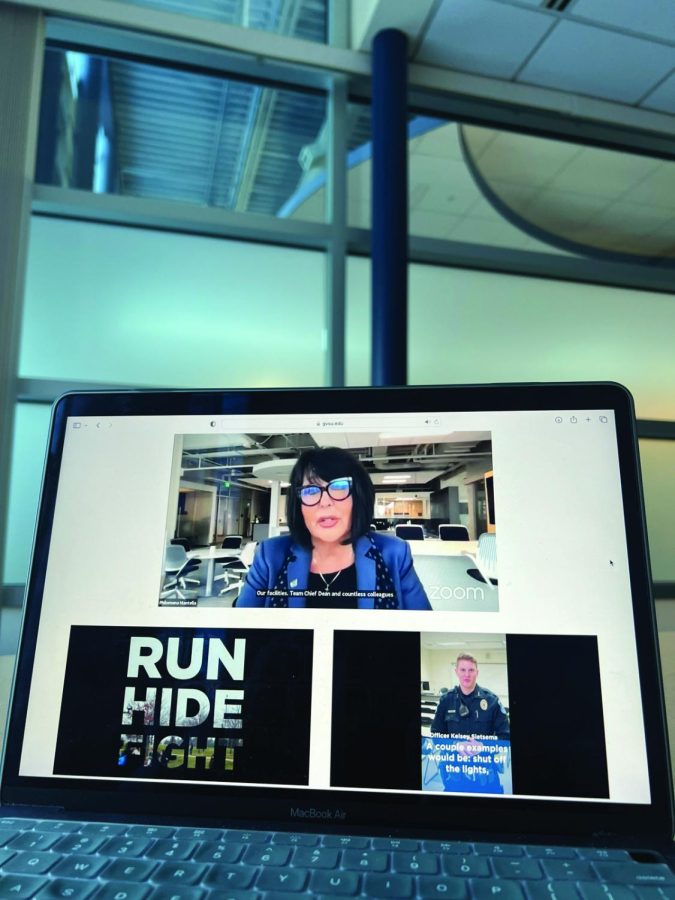GV holds safety briefing following shooting at MSU
Feb 27, 2023
The heads of emergency response of Grand Valley State University’s Department of Public Safety met with GVSU President Philomena Mantella over Zoom on Feb. 23 to review the university’s safety response plans.
Following the shooting at Michigan State University, staff and students alike have felt sadness, unease and grief for those affected by the tragedy. Many feel the university should increase preventative measures and have plans in place to promote security on campus.
The safety briefings were open to all GVSU community members. Originally scheduled for two in-person meetings on the Allendale and Pew campuses, the safety briefings were instead held on Zoom and Youtube Live due to the university’s remote status following inclement winter weather.
Students were informed of the change via an email from Mantella early on Thursday morning. The video presentation has been uploaded to the GVSU Active Shooter Response on the university website, as well as the official university YouTube channel.
The meeting began with a brief introduction from Mantella, acknowledging the tragic events and loss of life followed by a moment of silence to honor the victims of the shooting.
Mantella expressed pride in the “forward-leaning crisis plan infrastructure” at GVSU. She promised an increased effort from university administrators regarding campus safety practices to ensure all students are well informed, should an emergency take place.
“We are stronger in an event, should one befall us, if every person is attentive to our protocols, if every person is aware of our systems and infrastructure,” Mantella said. “I want to commit to (viewers) that we will increase the cadence of communication around safety so that as we go forward together as a community there will be multiple opportunities to learn more and dig deeper.”
GVSU Director of Public Safety and Chief of Police Greg DeHaan prefaced the briefings with a statement acknowledging the history of police brutality in America, reassuring students GVPD has the community’s best interests at heart.
“I acknowledge that policing on Americans historically has not always benefited those marginalized people, but understand this: Grand Valley State Department of Public Safety is your police department,” DeHaan said. “It’s our mission to provide a safe and secure environment in which our students live, work and learn.”
GVSU’s active shooter response plan involves a three-pronged effort: responding officers will surround, locate and neutralize the threat; transportation and rescue of victims and students and EMT response. This approach provides a predetermined hyper-focus on each aspect of danger to the student community.
The university employs many preventive measures for a situation of violence on campus in addition to post-reaction safety mechanisms to ensure the security of campus members.
DeHaan urged continued community activism and vigilance. He said it’s important to take a “see something, say something” approach and report potential threats. DeHaan said the active assailant often leaks information before committing acts of violence.
“The police department receives and reviews a number of intake reports from members of the community including CARE reports, Silent Observer, Campus Security Authority reports, 911 calls, texts to police, police reports from other agencies, social media and bulletins from local, state and federal agencies,” DeHaan said. “While physical security and technology are an important part of any safety and security plan, those solutions can also be defeated by those wishing to do harm, given enough time and determination. This is why it is so important that community members readily share any ‘leaked’ information as soon as it becomes known.”
DeHaan said the GVSU response policies are ever-evolving, as many of the safety measures and communication initiatives implemented on campus were done after a review of critical incidents occurring around the nation.
GVPD Sergeant and Emergency Manager William “Bill” O’Donnell reviewed the extensive safety systems in place on campus, including a 1,600-unit security camera system, emergency speakers, GVAlert!, the classroom lockdown system and the 24/7 dispatch center.
GVSU has in-classroom safety measures to protect students in the first few moments of an emergency, as well as giving students the resources to better protect themselves.
Each classroom features an emergency response “placard” posted on the wall above the light switch. The sign details important safety information, like locations of storm shelters and Automated External Defibrillators (AEDs), response plans and information that may be unique to that specific classroom.
Additionally, the Department of Public Safety has a comprehensive control system where the vast security surveillance is monitored with the assistance of a pre-programmed algorithm, monitoring suspicious or unusual activity.
Every single classroom on campus has a manual locking mechanism, which was installed across campus in 2017. The dispatch center houses a central lockdown system allowing all of the doors on each campus to automatically lock at the press of a button.
“We don’t want you to wait for us to push the lockdown buttons or feel like your safety is in jeopardy, we wanted that in the hands of our students and our faculty,” O’Donnell said. “Get those classrooms locked, don’t run out to the exterior doors, we will take care of that for you.”
There are 58 AEDs across campus, with two bleeding control kits inside each one. These feature tourniquets, chest seals and other supplies to be used for significant injuries.
“Everyone knows ‘stop-the-bleed,” O’Donnell said. “That’s that life-saving idea (behind) bleeding control kits, how we can stop people from dying from these incidents by having these things immediately in their hands.”
O’Donnell has credentials in firefighting, EMT work, hazmat first-response and law enforcement in addition to his emergency management status. He is a 25-year veteran of GVPD and GVSU alumnus.
GVSU’s physical security and technological solutions regarding emergency response make the university a leader in West Michigan, specifically in active shooter training.
All GVPD members are sworn licensed officers within the state of Michigan, attended police academies and are college graduates. Officers receive over 60 hours of training per year.
GVPD has a comprehensive dispatch system, with services available 24/7 across the entire university. Those defenses also send emergency messages via the GVSU alert emergency notification system for any critical incident.
“The shootings at Michigan State raised many questions from the campus community about our own security measures and what plans we have in place in the event of an emergency like an active shooter situation,” said Director of University Communications Christopher Knape. “President Mantella wanted to be sure our entire campus community had a chance to review our emergency response procedures and understand some of the systems we have in place to enhance safety and security around campus.”
The meeting provided insight for students and community members into the multi-level emergency infrastructure in place across the entire university, including pre-planning, incident response and post-incident responses.
Knape said the process of campus safety is consistently updated and will continue to adjust following insight gathered from MSU reports.
“We will continue to assess what happened in East Lansing and make adjustments, if needed, based on what we learn,” Knape said. “We are working on additional ways to engage and communicate with students, their supporters, faculty and staff in discussions about campus safety.”
For the full details of the safety briefings, watch the live stream cast on the GVSU active shooter response page.























